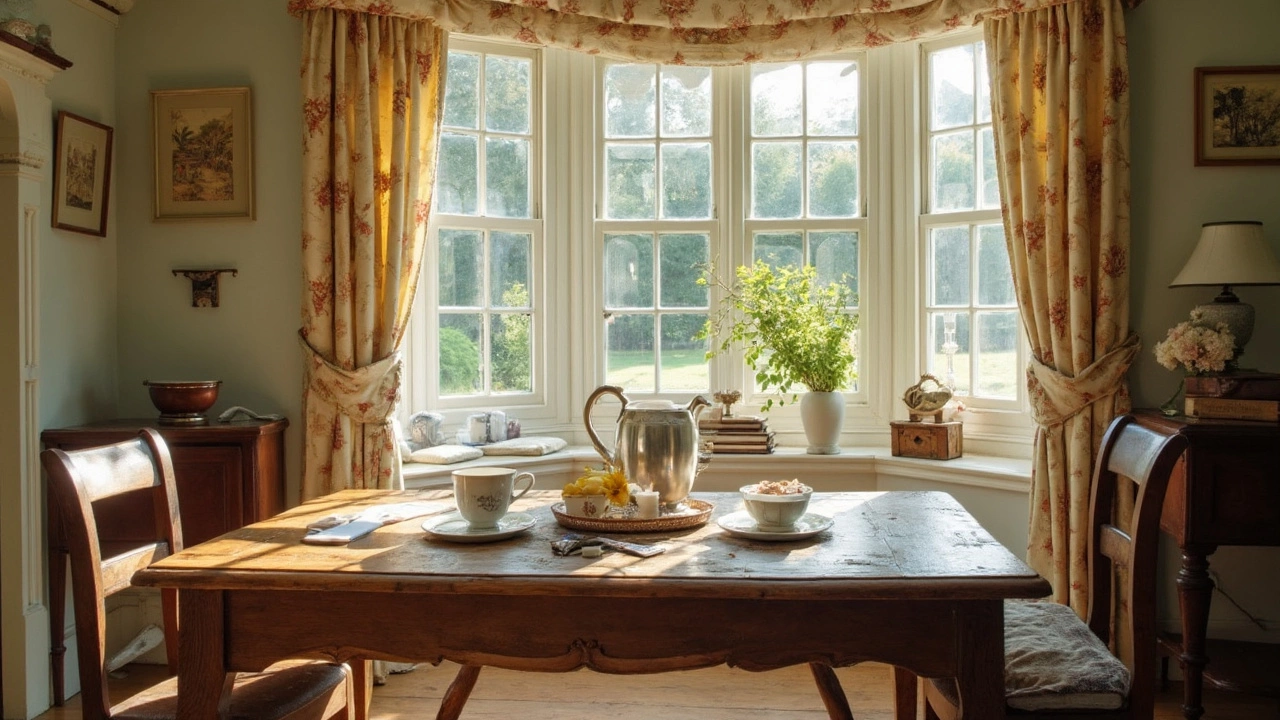Perfect Curtain Width for a 36-Inch Window
 Mar, 17 2025
Mar, 17 2025
Thinking about how wide your curtains should be for a 36-inch window? You're not alone! Picking the right curtain width can elevate your space, making it cozy or even more spacious. For starters, most decorators suggest that your curtain width should be about 2 to 2.5 times the width of the window. This means we're talking about curtains that are 72 to 90 inches wide. Surprised? It’s all about getting that full, luxurious look.
Before you whip out your tape measure, consider the style you’re going for. Do you want a sleek modern feel? Maybe aim for a bit less width. Dreaming of a plush, traditional vibe? Those extra inches can give your curtains the volume they need.
- Understanding Curtain Width Basics
- Measuring Your Window Correctly
- Choosing the Right Curtain Style
- Tips for Small Windows
- Common Mistakes to Avoid
Understanding Curtain Width Basics
Let's get down to the nitty-gritty of curtain width. For those working with a 36-inch window, the game is all about proportions. If your goal is fullness, and trust me, that's key for a polished look, you'll want those curtains, or total fabric width, to be around 2 to 2.5 times your window width. So, curtains with a width between 72 to 90 inches total will nail it.
Why the extra inches? It's all about getting that gentle wave of fabric that screams 'I've got style!' instead of the stiff, hardly-moving look. Plus, it’s super helpful when you want to keep light out or just need some privacy without making the room feel cramped.
Determining Aesthetic and Functionality
Think about what you want—minimalist or grand? Double the width can give you a rich fold, while a lesser width might suit a modern, clean-line setting.
Common Curtain Fabric Widths
Most curtain panels you find in stores come in standard widths like 54 inches. You might need a couple of these panels to reach your desired width. It's all about doing a bit of math or just grabbing two (sometimes three) panels per side.
| Fabric Width | Fullness Factor |
|---|---|
| 72 inches | 2x the window |
| 90 inches | 2.5x the window |
Remember, if your heart is set on specific fabrics or prints, custom curtains could be the way to go, even if it means a bit more planning.
- Tip: Always round up your measurements rather than down if you're unsure. Too wide is better than too narrow!
- Pro Tip: If you're unsure, try using a curtain width calculator online—super handy and saves time!
Measuring Your Window Correctly
Getting the right measurements for your window can make a world of difference when deciding on curtain width. First off, you'll need a good tape measure. A metal one works best for accuracy. Grab a pad to jot down the numbers, because you're going to need those later.
Width Measurement Basics
To kick things off, measure the width of your window from edge to edge. It seems simple enough, but a little precision goes a long way. For a 36-inch window, measure the exact width of the window frame. You might want to add a few inches on either side if you plan on using curtain rods that extend beyond the frame. This lets more light in and can help your room look larger.
According to John Hine, a well-known interior designer, "Proper measuring ensures your curtains hang beautifully and function correctly. It's a simple step, but one that should never be skipped."
Height Matters Too!
While we're on the topic, take note of the height from the rod to where you want the curtains to fall. Whether you prefer them brushing the floor or hanging just above a radiator, this measurement is key for that perfect drop.
Let's not forget about style decisions at this stage. Would you like your curtains to create a certain ambiances, like grazing the floor or just covering the window? For full-length drapes, consider measuring from a few inches above the window frame to the floor for that dramatic look.
The Stackback Factor
Another aspect to keep in mind is called 'stackback.' This is how much room your curtains take up when fully open. It's usually around 10-20% of the window's width, so don't skip this bit when doing your math.
Need some quick math? Let's say your window is precisely 36-inches in width, but your rod extends 4 inches on each side. This accounts for a total of 44-inches eligible for curtain width. Now, double it to get a gorgeous pile, which means curtains should be around 88 inches wide in total for both panels.

Choosing the Right Curtain Style
Picking the right curtain style isn’t just about looks. It impacts how light enters your room, your privacy, and even the room's overall vibe. So, let's break it down.
Consider Your Needs
First off, think about what you want your curtains to do. Need them to block out light? Go for heavy blackout curtains. Want more light coming in? Sheer or lightweight fabrics could be your best friends.
Match the Room's Decor
Your room’s design plays a big role in curtain style choices. If you have modern decor, sleek grommet or eyelet curtains offer clean lines and contemporary vibes. For something classic, pleated drapes might be just what you need.
Types of Curtain Styles
There are tons of styles out there, but here are a few popular ones:
- Rod Pocket: Perfect for a quick setup, giving off a casual and relaxed look.
- Tab Top: Great for informal rooms like kitchens or casual dining areas.
- Pinch Pleat: This traditional style adds a touch of elegance, perfect for a formal dining room or living room.
The Finishing Touch
And don’t forget hardware! Your curtain rods and finials should complement both your curtain style and room decor. Opt for metallic finishes for a modern look or wooden rods for a rustic touch.
Choosing the right curtain style is all about balance – matching your personal taste with your room’s function and style. Get it right, and your room will thank you!
Tips for Small Windows
Small windows can be tricky. You don't want to overwhelm them, but you also don't want them to look underdressed. Here’s how to strike the right balance and make the most out of your tiny frames.
Go Wide with Rods
One cool trick is to extend your curtain rod a bit beyond the window frame. This helps create an illusion of a larger window, especially when the curtains are open. So, for your curtains, get a rod that’s 6-12 inches wider than the window on each side. It’s a simple hack that does wonders!
Play with Length
For small windows, consider letting your curtains touch the floor, even if the window height doesn't require it. This extends the look and feel of the window vertically, adding elegance and height to your room.
Choose Light Fabrics
Avoid heavy, bulky drapes which can make small windows feel cluttered. Opt for light and airy fabrics like linen or cotton. These materials allow light in, making spaces feel open and bright.
Stick to Simple Designs
Busy patterns can overwhelm a small window space. Instead, stick to simple or solid designs. If you love patterns, go for something understated—subtle stripes or a soft texture can add interest without overpowering the room.
Consider Tiebacks
Using tiebacks can help control the drapes, giving you options. When tied back, they reveal more of the window and brighten the room without losing the comfort that closed curtains provide.
Remember, with decor, it's about making thoughtful choices tailored to your space. Use these tips to highlight your small windows without overpowering them.

Common Mistakes to Avoid
When hanging curtains, even the small things matter. Many folks slip up with their curtains and might not even notice until it’s too late. Let's keep your decor game on point by avoiding these blunders:
1. Skipping the Measure Tape
This might sound basic, but it’s easy to overlook. Always measure your window before buying curtains. Eyeballing it rarely works out. Write down the width and add extra inches for fullness. You’re aiming for an inviting look, not a stingy one.
2. Ignoring the Rod Length
Think about the rod too! It should extend beyond the window frame to let light in and make windows appear larger. A good rule? Extend the rod 3-6 inches beyond the window on each side.
3. Choosing the Wrong Style
The curtain style affects your choice in width. Heavy, dramatic styles need more width for elegance, while light, airy ones might not. Consider the room's vibe and go from there.
4. Settling for Short
Don’t settle for curtains that just pass the window edge. Floor-length drapes often give a sleek look, creating an illusion of taller windows. If floors aren't your thing, aim for curtains to hover half an inch above the window sill.
5. Overlooking Layers
Layering isn't just for clothes. Consider layering different curtain types, like a light sheer with a heavier drape. It adds decor depth and versatile light control options.
| Mistake | Solution |
|---|---|
| Skipping Measurements | Use a tape measure before buying. |
| Rod Too Short | Extend 3-6 inches beyond frame. |
| Wrong Curtain Style | Match style to room decor. |
| Settling for Short | Opt for floor-length drapes. |
| Ignoring Layers | Combine sheer with heavy drapes. |
By keeping an eye out for these pitfalls, you'll master the art of dressing up your window. Happy decorating!